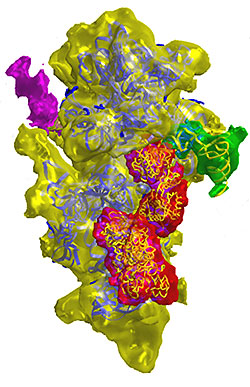The Brierley lab., in close collaboration with the group of Dr Andrew Firth, study the regulation of virus gene expression at the level of protein synthesis, especially the phenomenon of ribosomal frameshifting. During translation, ribosomes generally stay in register and decode each codon triplet by triplet. However, some viral mRNAs have embedded signals that instruct ribosomes to change register, ie: to frameshift, at a defined position and to continue translation in an overlapping reading frame. Frameshift signals are exploited by many viruses to co-ordinate gene expression from overlapping coding sequences. The best studied examples come from the retroviruses. Here, the coding region for the enzymatic functions of the virus (pol) often overlaps the upstream structural protein coding sequences (gag) and is in the -1 reading frame. Expression of the pol gene requires a -1 frameshift at the end of gag and the Pol protein is produced as a fusion with the Gag protein. Our aim is to understand the frameshift process with a view to inhibiting it and thus to prevent virus replication. Many other RNA viruses have been shown to utilise a frameshift strategy in their replication cycle and there are emerging examples in cellular genes. A closely related translational phenomenon, termination codon suppression (readthrough), has also been described. Here, viral mRNA signals cause the misreading of stop codons, and an amino acid is inserted instead, at a certain frequency, resulting in an elongated polypeptide.
We are studying frameshifting and readthrough using coronaviruses and retroviruses as model systems. A frameshift signal has two elements, a "slippery sequence" where the ribosome enters the new reading frame, followed, in most cases, by an mRNA structure, often an RNA pseudoknot. A bipartite signal is also employed in readthrough but here, the pseudoknot induces suppression of an upstream stop codon. Recently, we have also identified novel signals where there is no stimulatory RNA structure and frameshifting is stimulated by the binding of trans-acting proteins. Our aim is to determine the mechanism by which these stimulatory signals induce the ribosome to change frame/misread the stop codon. Further, we are interested in gaining an understanding of RNA pseudoknot structure and function. The pseudoknot motif has been described in all cellular RNAs described to date and pseudoknots are clearly key regulatory RNA elements. Projects are underway to study
(1) Transacting factors, both protein and RNA, which influence frameshifting/readthrough (2) the structure of frameshift and readthrough stimulatory RNAs and proteins (3) ribosome conformation during frameshifting/readthrough (4) the effect on virus replication of altering frameshift/readthrough efficiencies.
We are also using the technique of ribosome profiling to globally-analyse RNA virus translation and virus-host responses. We are particularly interested in identifying novel examples of translational control.
Professor Ian Brierley
Principal Investigator
|
Dr Sawsan Napthine Research Associate |
Conor Fairhead PhD Student |
Michal Varga PhD Student |
|
|





